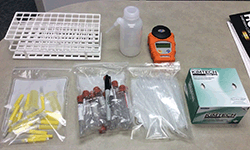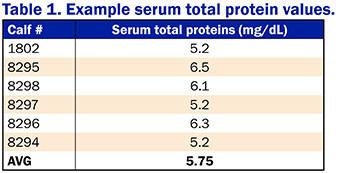
NEW! Calf Program Checklist: Measuring Serum Total Protein – Dr. Noah Litherland, Vita Plus
 By Dr. Noah Litherland, Vita Plus dairy youngstock technical specialist
By Dr. Noah Litherland, Vita Plus dairy youngstock technical specialistSerum total protein analysis is a simple and repeatable way to evaluate passive transfer of immunoglobulins in dairy calves up to five days of age. When colostrum is fed, the immunoglobulins are absorbed through the intestinal wall and into the bloodstream, where they interact with tissues in the body to provide passive transfer of immunity from the dam to the calf.
Immunoglobulins are mostly protein, so absorption of immunoglobulins increases serum total protein concentration. At birth, calves have a serum total protein of around 4.2 mg/dL. A serum total protein above 5.5 mg/dL indicates at least a minimum amount of immunoglobulins were absorbed by the calf.

Equipment needed:
- Vacutainer needles (1 inch)
- Red top vacutainer tubes
- Needle holding hub
- Permanent marker or pen
- Tube holding rack
- Disposable transfer pipettes
- Refractometer
- Kimwipes for cleaning the refractometer between samples
- Squirt bottle for rinsing the refractometer between samples
Steps for conducting and measuring serum total protein:
- Assemble all necessary supplies to collect, process and measure serum total proteins.
- Select calves that are at least 24 hours of age, but not greater than five days of age.
- Consult a veterinarian for jugular collection technique. I find that, by straddling the calf and tucking the nose of the calf under my left elbow, I can use my left hand to apply pressure to the jugular vein about three inches below where I will collect the blood. With my needle, hub and vacutainer tube, I puncture the jugular vein with the needle and then push the vacutainer up into the hub so the second end of the needle allows blood to fill the vacutainer tube. If blood does not flow right away, try slightly backing the needle out or repositioning the needle if it is not in the jugular vein. Fill tubes at least 50-percent full of blood. Cap the needle for disposal in a sharps container.
- Label the vacutainer tube with the calf ear tag number using a permanent marker.
- Store the vacutainer tube upright overnight or place the vacutainer tube in a centrifuge to spin and separate serum.
- If tubes stand overnight, serum will naturally separate by the next day.
- Place two drops of serum onto the refractometer and read and record the serum total protein value.
The average serum total protein in the data set in Table 1 is 5.75 mg/dL, which is acceptable, but the three calves with values of 5.2 mg/dL are low. Further investigation would be warranted to better understand what factors contributed to low serum total protein.

Factors that decrease passive transfer include:
- Delayed colostrum feeding
- Feeding insufficient amounts of colostrum
- Providing colostrum with high bacterial count
- Providing low-quality or diluted colostrum
- Heat stress in the dam and calf
Factors that increase passive transfer include:
- Feeding colostrum within two hours after birth.
- Feeding at least 3 to 4 quarts of colostrum at birth and another 2 quarts six to eight hours later.
- Using hygienic practices to harvest colostrum soon after calving, rapidly cooling colostrum to refrigeration temperature, and heat-treating colostrum for 60 minutes at 140 degrees F, followed by cooling for feeding or storage.
- Test colostrum with a Brix refractometer to ensure colostrum is above 22-percent Brix.
- Emphasize environmental quality for both the dam and the calf, including heat stress prevention for the cow during gestation and for the calf during the nursery phase.
| Category: |
Animal health Colostrum management Equipment Starting Strong - Calf Care |

